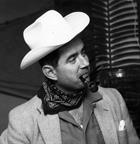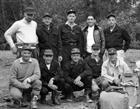Commander Don Sheppard
© Peter Hore
Commander Don Sheppard, who has died aged 94, saw service from the Arctic to the Far East and became an air ace while only 21.
On the afternoon of January 4, 1945 during the Fleet Air Arm raid on Pangkalanbrandan, an oil-terminal in North Sumatra, Sheppard flew fighter cover over a force of some 100 aircraft from three British carriers, Victorious, Indomitable and Indefatigable. He saw enemy fighters ‘coming straight down at top speed and as I rolled over to attack [one] he attempted to evade me by rolling over on his back and pulling through but I fired a burst at him from short range and he bailed, whether he was hit or because he was merely frightened’. While regaining height to re-join the escort Sheppard saw a second Japanese Oscar fighter and ‘was able to quickly despatch him’.
He was wingman to Lt Col Ronnie Hay RM [DT 24 Dec 2001], was in overall charge of the attack, who wrote that Sheppard had ‘shown the greatest keenness and determination to get to grips with the enemy; He has trained himself to a high standard of skill in the air and had made every effort to become a first class fighter pilot. He was worked with energy and success improving the standard of armament maintenance in the squadron’. The latter was a reference to Sheppard’s role in ensuring that that every gun in his squadron worked and that there were no jams. He was awarded the DSC.
Then on January 24, while flying combat air patrol during a raid on Japanese-held oil refineries at Palembang, Sheppard was jumped from above by another Oscar; Sheppard turned his aircraft and hit the Japanese with his second burst. During another raid, five days later ‘a vigorous dogfight’ developed at low level ‘against a very competent and aggressive opponent’, when Sheppard shared two kills with Hay.
By May 1945 the allies were gaining air superiority, and the Japanese introduced kamikaze, or suicide air attacks. Sheppard, now a leader of his own flight of three Corsairs, was launched to investigate an intermittent radar contact. High above him just out of the cloud, Sheppard spotted a Japanese dive-bomber, which he shot down at his first pass, He could not avoid a massive fireball, but nursed his damaged aircraft back to Victorious.
Donald John Sheppard was born in Toronto where his father was a lawyer and mother a schoolteacher, and he was educated at Lawrence Park Collegiate Institute, Toronto. With his two brothers they spent their summers on Lake Simcoe where they learned to sail: all would join the wartime Royal Navy.
Don, inspired by reading about the Fleet Air Arm’s attack on Taranto and the hunt for the Bismarck, volunteered and took ship to England to join No 38 Pilots Course. After basic training he recrossed the Atlantic to learn to fly, and first flew solo in September after 13 hours. On his first day in 738 Naval Air Squadron, unused to the higher torque of the high performance machines with which the FAA was becoming equipped, he made a rare pilot error and crashed on take-off, but soon he had clocked up several score hours flying in single-engined warplanes.
In October 1943 Shepard joined 1835 NAS and learned to fly the Chance Vought Corsair, which had been rejected as a carrier aircraft by the USN. With its air of scarcely concealed menace, it inspired almost as much fear in the hearts of those who were going to fly it as in the enemy, but once mastered it could out-fly most aircraft, and it had an endurance of five hours. Sheppard made his first deck-landing on USS Charger on 22 November 1943, and in March 1944 he embarked in the British fleet carrier Victorious to prepare for Operation Tungsten, the raid on the German battleship Tirpitz which was hiding in Kaafjord in northern Norway. On April 3 1944, the German was hit by 16 bombs which left her useless as a warship. After further raids in northern waters, Victorious deployed to the Far East.
Postwar Sheppard joined the Royal Canadian Navy, where he completed 112 decklandings and flew 2,655 hours in 25 types of aircraft. After six years at NATO Headquarters in Europe he retired in 1974. Sheppard never bragged about his war, and embraced reconciliation, his son once finding him watching old television movies with a German who had been in his gunsights.
Sheppard farmed for several years in the Annapolis Valley, Nova Scotia. An avid woodsman, who fed his young family on moose and salmon, gradually his relationship with animals changed, and he gave up hunting. He wept openly when his favourite horse was struck by a car. Instead he built a home overlooking Aurora, Ontario, where he enjoyed walking his dogs in the early mornings before the golfers were up. There he and his wife hosted a new generation of children, and he was the best of neighbours, up early after snowstorms to clear their drives, and for many years driving the elderly to medical appointments and picnics at the beach.
In 1947 he married Gwen Falls, the sister of a fellow navy pilot, the future Canadian Chief of Defence Staff, Admiral Robert Falls. They married in December, for maximum tax benefit, and after a brief, extravagant wedding at Toronto’s Royal York Hotel, they set off in his old car on the long drive to Nova Scotia, and spent their honeymoon broken down in a blizzard in rural New York. She predeceased him in 2016 and he is survived by three daughters and two sons.
A brother who also flew Corsairs, was killed in a flying accident in the carrier Formidable in March 1945.
Don Sheppard, born January 21, 1924, died May 2, 2018.






